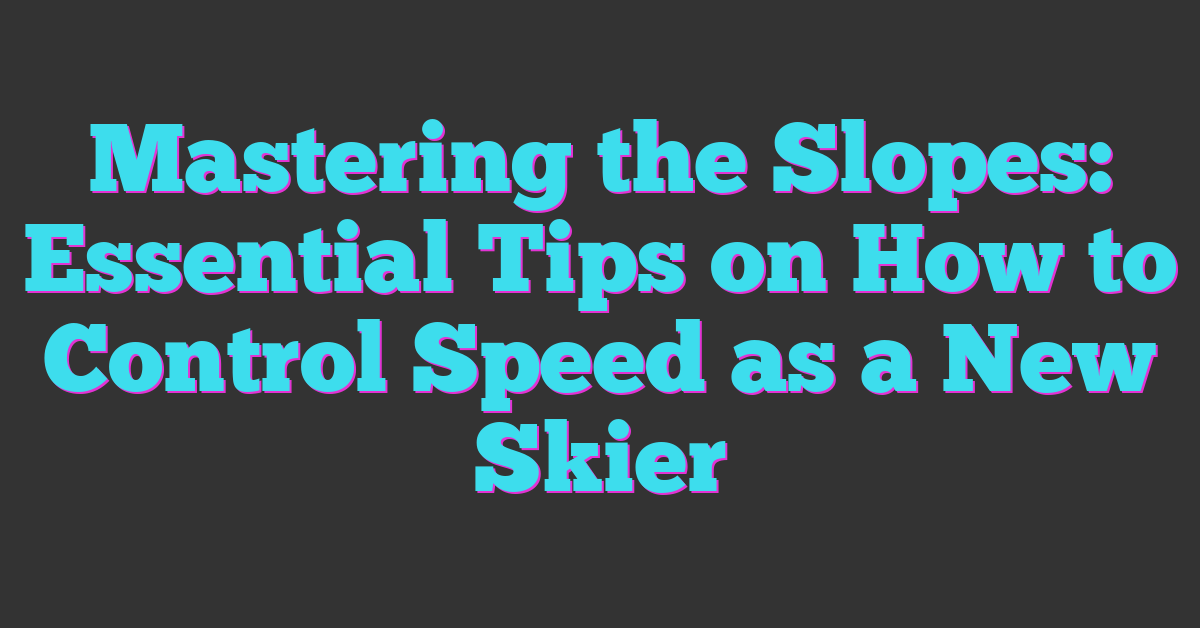Hitting the slopes for the first time is both thrilling and a bit nerve-wracking. As a new skier, mastering speed control can feel like a daunting task, but it’s essential for building confidence and enjoying your time on the mountain. Trust me, I’ve been there!

Finding the right techniques to manage your speed can transform your skiing experience. Whether you’re gliding down gentle slopes or tackling steeper runs, learning to control your pace will help you feel more in control and less anxious. Let’s dive into some simple strategies that’ll help you slow down, speed up, and enjoy every moment on your skis.
Understanding the Basics of Skiing
Skiing combines technique, balance, and control. Understanding how to manage speed is essential for any new skier aiming to have fun and build confidence on the slopes.
Importance of Speed Control
Speed control significantly enhances the skiing experience. It allows skiers to navigate slopes safely and confidently, reducing the risk of falls and accidents. Controlling speed helps skiers enjoy challenging runs while mastering their skills. Practicing speed control techniques leads to smoother descents, making skiing more enjoyable and less intimidating.
Key Terminology in Skiing
Familiarity with skiing terminology aids in effective communication and understanding of techniques. Key terms include:
- Edge: The metal strip on the ski that grips the snow, allowing for turning and control.
- Pizza (Snowplow): A technique for slowing down by forming a wedge with the skis.
- Parallel Skis: Keeping skis side by side for balanced and controlled turns.
- Carving: A technique that involves making clean, arched turns using the edges.
- Groomed Runs: Slopes that have been smoothed out for easier skiing, perfect for practice.
These terms form the foundation for mastering skiing skills and navigating the slopes effectively.
Techniques to Control Speed
As a passionate skier, I know that mastering speed control is vital for enjoying the slopes. Here are some effective techniques to help you manage your speed confidently.
The Snowplow Technique
The snowplow technique, often referred to as “pizza,” involves positioning your skis in a wedge shape. To execute this, point the tips of your skis together while keeping the tails apart. This technique increases friction against the snow, enabling you to slow down. Practice this on gentle slopes; it’ll enhance your ability to navigate without losing control. The snowplow is particularly useful when approaching a stop or managing speed during turns.
Utilizing Edges for Speed Regulation
Utilizing the edges of your skis is another essential skill for speed control. By shifting your weight to your inside edge when turning, you create a deeper carve in the snow. This carving movement slows you down naturally while providing better control. Focus on feeling the angle of your skis against the snow. As you gain experience, practice alternating between edges to smoothly reduce speed during transitions. The more you practice, the more responsive your skis become, giving you greater confidence as you tackle various runs.
Body Position and Balance
Proper body position and balance are crucial for controlling speed while skiing. Understanding how to adjust posture can lead to a more enjoyable experience on the slopes.
The Role of Posture
Posture directly impacts speed control. I keep my knees slightly bent and my body centered over my skis. This stance lowers my center of gravity and enhances stability. I also lean slightly forward to maintain balance, as it allows me to react quickly to changes in terrain or speed. Keeping my shoulders relaxed and facing down the slope helps with weight distribution, which promotes smoother turns and slows down naturally.
Maintaining Balance on Skis
I focus on maintaining balance by distributing my weight evenly between both skis. This technique helps keep me in control as I navigate different slopes. When turning, I shift my weight to the inside edge of the ski that’s on the outside of the turn. By doing this, I create a stronger grip on the snow, which slows my speed. Practicing my balance on gentle slopes builds confidence before tackling steeper areas. Ultimately, maintaining balance is key; with practice, it becomes second nature, allowing me to enjoy my time on the mountain even more.
Practicing Speed Control
Practicing speed control is vital for new skiers. I find that dedicating time to mastering specific drills can enhance control, build confidence, and make skiing more enjoyable.
Recommended Drills for New Skiers
- Snowplow Drill: I start with the snowplow, positioning my skis in a wedge shape. This drill helps me feel the friction against the snow, allowing me to slow down on gentle slopes.
- Hockey Stop: I practice transitions between skidding and turning by initiating a hockey stop. This method boosts my ability to halt quickly, which is essential for avoiding obstacles or changing direction sharply.
- Side Slipping: I engage in side slipping by traversing across the slope while maintaining a controlled slide. This exercise enhances my edge control and helps me manage speed effectively.
- Figure Eights: I carve figure eights on gentle terrain, focusing on weight distribution and balance. This drill reinforces proper body positioning and encourages smoother turns while providing speed control practice.
- Shifting Weight: I practice shifting my weight from one ski to another. This exercise improves my understanding of how weight distribution affects speed and allows me to refine my turns.
Tips for Gaining Confidence
- Start on Gentle Slopes: I always choose gentle runs for initial attempts. Familiarity with the terrain reduces anxiety and builds confidence in speed control.
- Take Breaks: I allow myself to take breaks when needed. Resting helps me regain focus and reduces the chances of panic while honing my skills.
- Ski with Friends: I enjoy skiing with friends or instructors who provide support and encouragement. Their presence helps me feel more at ease on the slopes.
- Set Small Goals: I establish achievable objectives for each skiing session, such as mastering the snowplow or completing a set number of turns. These small victories boost my morale.
- Practice Visualization: I visualize my movements and techniques before executing them. This mental practice prepares me to manage speed effectively and increases my confidence on the slopes.
Safety Considerations
Skiing provides incredible thrills, but safety plays a significant role in enhancing your experience. Paying attention to your surroundings and wearing the proper gear ensures you stay safe on the slopes.
Awareness of Surroundings
Awareness of surroundings is crucial for safe skiing. I stay vigilant for other skiers, snowboarders, and obstacles like trees or signs. I keep an eye on the terrain, adjusting my speed and direction based on conditions. Always look uphill before starting down a slope, as it’s easier to see less experienced skiers. Staying within designated areas also helps avoid hazards. Ski areas often post signs and warnings. Following these guidelines is essential for avoiding accidents and ensuring a fun day on the mountain.
Proper Gear for New Skiers
Wearing proper gear is vital for comfort and safety while skiing. I recommend a well-fitted helmet, as it protects against injuries from falls or collisions. Investing in quality ski goggles is important too; they shield my eyes from the sun’s glare and improve visibility during snowy conditions.
Choosing the right ski clothing enhances warmth and mobility. I prefer waterproof, breathable jackets and pants to stay dry and comfortable. Layering helps regulate body temperature, so I opt for moisture-wicking base layers and insulated mid-layers. Lastly, wearing appropriate ski socks prevents cold feet and blisters. My gear setup ensures I’m prepared for whatever the slopes throw my way.
Conclusion
Mastering speed control is a game changer for any new skier. It not only boosts your confidence but also makes your time on the slopes way more enjoyable. With practice and the right techniques you’ll find yourself navigating those runs with ease.
Remember to focus on your body position and weight distribution as you practice. The more you familiarize yourself with the skills and drills mentioned the more comfortable you’ll feel.
So grab your gear hit the slopes and embrace the thrill of skiing. Each run is an opportunity to improve and have fun. You’ve got this!
















